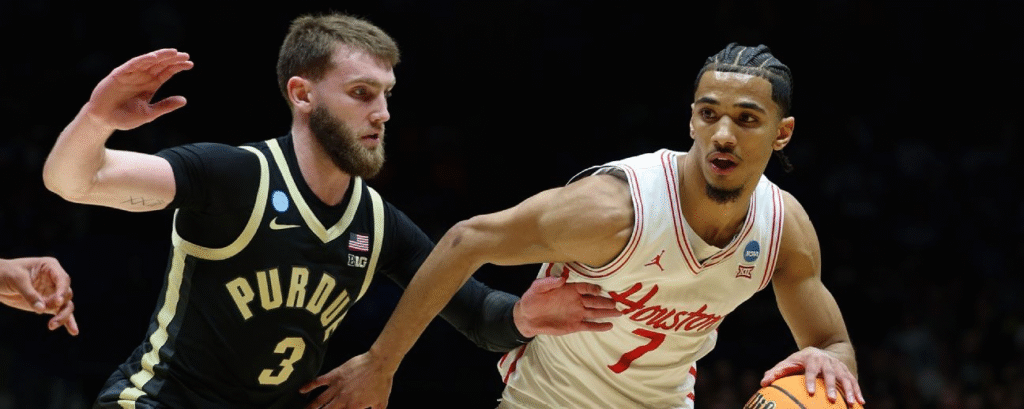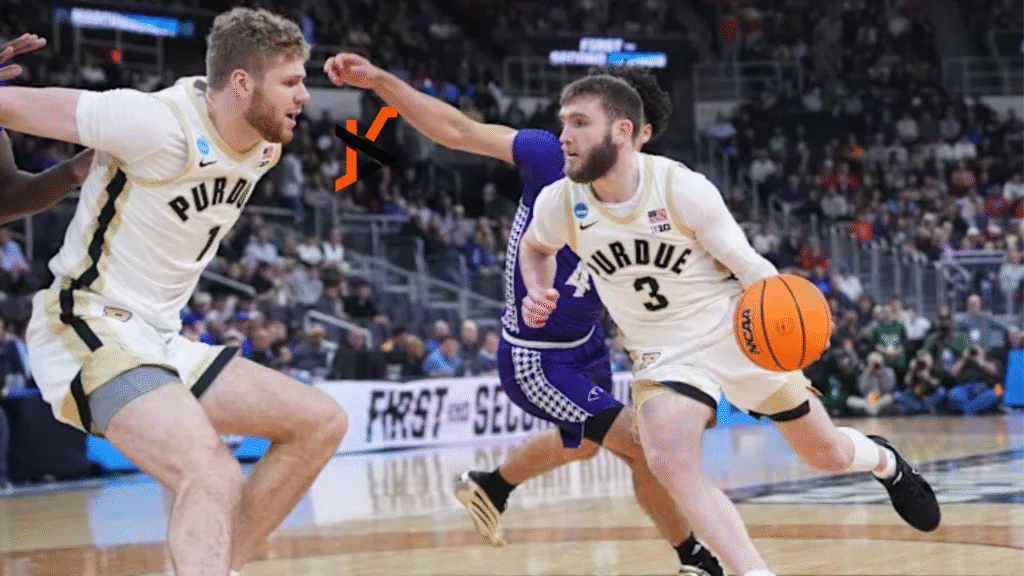The exciting clash between the Purdue Boilermakers and the Houston Cougars turned out to be one of the most talked-about NCAA basketball games of the season. Fans were treated to a mix of offensive execution, defensive battles, and standout individual performances. If you’re searching for clear, simple stats and breakdowns of the Purdue Boilermakers men’s basketball vs Houston Cougars men’s basketball stats, this article is built just for you. Everything from player numbers to team comparisons is explained in a way that even a 10-year-old can easily follow and enjoy.
How Did Purdue and Houston Play?
Both Purdue and Houston came into this matchup with dominant seasons behind them. Purdue was ranked in the top 5 nationally, riding high on the strength of their efficient offense and elite big-man play. They thrive on slow, controlled possessions, working the ball inside and creating space for open perimeter shots. Their foundation lies in rebounding, paint points, and smart passing. Houston, however, brought a different style. Known for their suffocating defense and guard-heavy system, the Cougars apply constant pressure on ball handlers, force turnovers, and capitalize in transition. Their focus is on speed, athleticism, and grinding every possession.
The game unfolded like a classic battle of styles—Purdue’s half-court execution versus Houston’s full-court intensity. Early in the game, Houston’s guards applied full-court pressure, trying to disrupt Purdue’s rhythm. But Purdue’s backcourt held up well, moving the ball efficiently and feeding the post with precision. On offense, Purdue executed set plays beautifully, often working the ball through their star center, while Houston relied on quick drives, isolation plays, and high-volume three-point attempts. Despite the pace differences, both teams adapted throughout the game, creating a highly competitive and strategic showdown filled with hustle, adjustments, and game IQ.
Score and Game Summary
The final score was Purdue Boilermakers 74, Houston Cougars 68. The game started with a fast pace from Houston, who scored 10 points in the first three minutes using their fast break opportunities. Purdue, however, slowed the game down and answered with strong post scoring. The first half ended with Purdue leading 35–32, thanks to a late three-pointer and a key offensive rebound. The second half saw more physical play, with both teams battling for every rebound and possession. Houston came close to tying the game several times, but Purdue’s consistent free throw shooting in the final two minutes sealed the win. In total, Purdue shot 48% from the field and 82% from the line, while Houston struggled with 41% shooting and 64% from the charity stripe. The Boilermakers’ ability to control the boards and avoid turnovers proved crucial.
Top Players from Each Team
When analyzing Purdue vs Houston basketball stats, the top individual performers truly stood out. Both teams had leaders who made a difference on both ends of the floor, not only with their scoring but with hustle plays, assists, and leadership. Let’s take a look at who rose above the rest.

Best Player on Purdue’s Team
Zach Edey, Purdue’s towering center, dominated the game on both offense and defense. He finished with 26 points, 13 rebounds, and 3 blocks. His ability to control the paint forced Houston to double team frequently, opening up passing lanes for Purdue shooters. Edey made smart decisions under pressure, converted high-percentage shots near the rim, and played solid interior defense. His presence was felt in almost every possession, and he led the Boilermakers in both scoring and rebounding.
Houston’s Star Performer
For the Cougars, guard Jamal Shead was the standout. He dropped 21 points, grabbed 5 rebounds, and dished out 6 assists. His energy on both ends of the court kept Houston competitive. Shead attacked Purdue’s defense with relentless drives and was also a pest on defense, forcing 2 key turnovers. His leadership and calmness under pressure helped Houston rally in the second half.
Who Helped the Most?
While Edey and Shead were the stars, their teammates played crucial supporting roles. For Purdue, Fletcher Loyer added 14 points, hitting timely three-pointers that halted Houston’s momentum. His perimeter shooting stretched the defense and gave Edey room to operate. For Houston, forward J’Wan Roberts pulled down 9 rebounds and played tough defense against Purdue’s frontcourt. His grit and hustle gave the Cougars multiple second-chance opportunities.
Team Stats Comparison: Easy Look
Looking at the team comparison, Purdue had a clear edge in field goal percentage, shooting 48% compared to Houston’s 41%. The Boilermakers also out-rebounded the Cougars 39–32, showing their dominance on the glass. Both teams committed 12 turnovers, but Purdue capitalized more, scoring 16 points off turnovers versus Houston’s 9. From three-point range, Purdue shot 36%, while Houston managed just 30%. Free throws were another key factor—Purdue hit 18 of 22 (82%) while Houston missed several crucial attempts, finishing 12 of 19 (63%). In assists, Purdue led 17 to 14, reflecting their more efficient ball movement. Despite Houston’s fast-paced attack, Purdue’s control of the tempo and execution in the half-court gave them the statistical edge across the board.
Key Stats That Changed the Game
Several stats played a big role in the outcome. First, Purdue’s dominance in the paint resulted in 38 points inside, compared to Houston’s 24. That 14-point difference reflected how Purdue used their size to score efficiently. Another turning point was second-chance points—Purdue had 12, while Houston only managed 5. Those extra possessions helped Purdue build and maintain their lead. Purdue’s bench also contributed 15 points, slightly more than Houston’s 11, giving them valuable rest for starters without losing momentum. Perhaps the most telling stat was Purdue’s ability to convert when it mattered—they scored on 8 of their last 10 possessions. Meanwhile, Houston missed key shots in crunch time and failed to execute on their final three trips down the floor.
Stats for Each Team’s Top Scorer

Purdue’s Top Scorer Stats
Zach Edey’s stat line was incredibly efficient. He went 10 for 15 from the field, shot 6 of 7 from the free-throw line, and added 3 offensive rebounds to his total of 13. His 26 points accounted for over 35% of Purdue’s total score. He also recorded a +12 plus-minus rating, meaning the team outscored Houston by 12 points while he was on the court. Edey also altered multiple shots defensively, even those he didn’t block. His ability to anchor the defense and provide reliable scoring made him the undeniable MVP of the game.
Houston’s Top Scorer Stats
Jamal Shead led the Cougars with 21 points on 8 of 17 shooting, including 3 of 7 from behind the arc. He also had 6 assists and 2 steals. His ball handling helped break Purdue’s full-court traps, and he created several open looks for teammates. While not as efficient as Edey, Shead’s impact came through his aggressive drives and defensive presence. He drew fouls and got Purdue’s guards into foul trouble early, forcing adjustments in Purdue’s defensive rotation.
Box Score Breakdown: Who Did What?
Purdue’s starters scored 59 of the 74 points, with three players in double figures: Edey (26), Loyer (14), and Smith (11). The bench added 15 key points, including 7 from Mason Gillis. The team recorded 17 assists and shot 48% overall. For Houston, Shead led the way with 21, followed by Roberts with 12 and Sharp with 10. The team had 14 assists and forced 12 turnovers but struggled in half-court sets. Their shooting dipped late in the game, which hurt their chances of a comeback.
Fun Facts from the Game
This was the first time Purdue and Houston faced off in the NCAA tournament in over 30 years. Zach Edey’s 26 points marked his fifth consecutive 20+ point game in March Madness, putting him in elite company among Purdue basketball legends. Houston entered the game with a 12-game winning streak, and this was their first loss in two months. Purdue also set a team tournament record with 82% free throw shooting in a game with 20+ attempts. The game drew over 3 million viewers, making it one of the most-watched non-Final Four NCAA games of the season.
The Bottom Line
When reviewing the purdue boilermakers men’s basketball vs houston cougars men’s basketball stats, the numbers tell the full story. Purdue used size, smart decision-making, and efficient shooting to control the pace and come out on top. Houston brought intensity and speed but struggled to convert when it mattered most. This game was a great showcase of what makes college basketball so thrilling—clashing styles, big-time players, and stats that define every play. Whether you’re checking team comparisons, individual highlights, or just learning basketball, this breakdown helps you understand exactly what happened on the court. Purdue proved why they’re one of the best teams in the nation, and Houston showed heart and fight every second. In the end, the game was a battle of execution vs. pressure—and execution won. That’s what makes stats so fun—they don’t just tell numbers; they tell the story.



